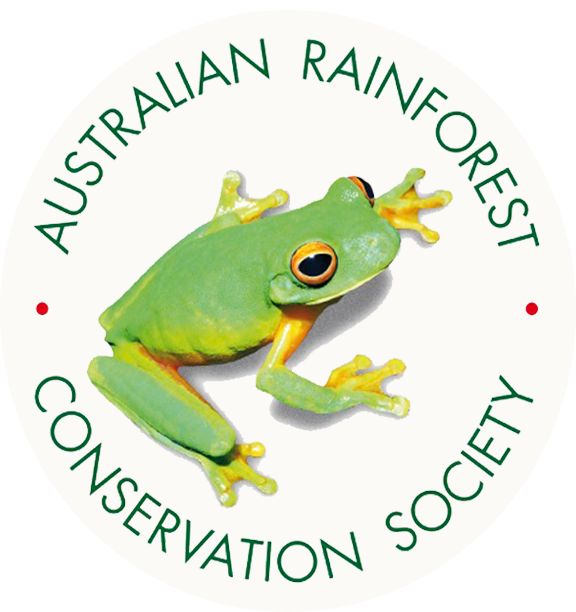|
World Heritage Values of Springbrook
Essentially all of the World Heritage values described for the Gondwana Rainforests of Australia can be found at Springbrook. The values are listed below with reference to species recorded at Springbrook.
Springbrook’s unique climate
Springbrook is the wettest part of the Australian continent outside the wet tropics of northeast Queensland. The high country at the southern end of the Plateau is commonly immersed in cloud. It can be deduced that this local climate is similar to the climate (the palaeoclimate) that existed across much of the continent when it was essentially covered with rainforest. In other words, the high country of Springbrook represents a refugial area that has preserved conditions that have allowed the survival of ancient lineages of plants and animals — elements of the biota that contribute significantly to the World Heritage values. It is of critical importance that these local climatic conditions are maintained and expanded. The greatest threat to this outcome is clearing of rainforest and disruption to the canopy through creation of gaps for houses, roads, powerlines, communications towers, etc. It is a fundamental objective of Springbrook Rescue to restore the environmental integrity of the high country of Springbrook.
Criterion 1: Outstanding examples representing the major stages of the earth's evolutionary history.
- Rainforests which are exceptionally rich in primitive and relict species, many of which are similar to fossils from Gondwana.
- Subtropical rainforest habitat.
- Warm temperate rainforest habitat.
- Ancient ferns and tree ferns.
- Conifers (e.g. hoop pine) and cycads.
- Primitive plant groups within Magnoliales and Laurales — Tasmannia (pepper bushes), Doryphora (sassafras), Trimenia, Wilkiea, Cryptocarya, Litsea.
- Primitive plant groups within Rosidae and Dillenidae — Ceratopetalum (coachwood), Nothofagus (Antarctic Beech), Eucryphia jinksii, Akania (turnipwood), Pittosporum.
- Primitive group of Corvida — Albert’s Lyrebird, Rufous Scrub-bird, Satin Bowerbird, Regent Bowerbird, White-throated Tree-creeper, Red-browed Treecreeper.
- Other birds dating from Gondwana — Logrunner, Brown Thornbill, Buff-rumped Thornbill, Yellow Thornbill, Yellow-rumped Thornbill, Striated Thornbill, White-browed Scrubwren, Yellow-throated Scrubwren, Large-billed Scrubwren, Brown Gerygone, White-throated Gerygone.
- Frogs in the families Myobatrachidae — barred-frogs (2 species), Masked Mountain-Frog, Tusked Frog, Australian Marsupial Frog, Black-soled Frog, Clicking Froglet, Striped Marshfrog, Red-backed Broodfrog; and Hylidae —tree-frogs (Litoria, 11 species).
- Leaf-tailed Gecko and Southern Angle-headed Dragon.
- Monotremes (Short-beaked Echidna) and marsupials (at least 15 species).
- Invertebrate fauna with origins in Gondwana — Lamington Blue Crayfish, giant land snails, Richmond Bird-wing butterfly and glow-worms.
- Ecosystems and taxa which demonstrate the origins and rise to dominance of cold-adapted/dry-adapted flora, including cool temperate rainforest habitat.
- Plant species in the families Myrtaceae, Casuarinaceae and Proteaceae.
Criterion 2: Outstanding examples representing significant ongoing geological processes, biological evolution and man's interaction with his natural environment.
The Gondwana Rainforests of Australia provides outstanding examples of ongoing geological processes associated with Tertiary volcanic activity, and of biological evolution.
- The caldera of the Tweed Shield Volcano is considered one of the best preserved erosion caldera in the world and is notable for its size, its age (20 million years), and for the presence of a prominent central mountain mass with all three stages of the erosion of shield volcanoes (the planeze, residual and skeletal stages).
- Centres of endemism where ongoing evolution is taking place.
- Flora and fauna of low dispersal capability that occur in more than one isolated pocket of the Gondwana Rainforests of Australia.
- Plant taxa that show evidence of relatively recent evolution, including:
- Genera in Southern Hemisphere families (e.g. Winteraceae, Monimiaceae and Lauraceae in the Magnolidae, Proteaceae, Cunoniaceae, Euphorbiaceae, Escalloniaceae, Davidsoniaceae Pittosporaceae, Myrtaceae and Sapindaceae in the Rosidae and, Elaeocarpaceae, Sterculiaceae and Ebenaceae in the Dillenidae).
- Monotypic endemic families (e.g. Akaniaceae and Petermanniaceae).
- Animal taxa that show evidence of relatively recent evolution, including:
- 3 species of frogs in the myobatrachid genus Pseudophyrne believed to have diverged in the Pliocene.
- Species of frogs in the relict genus Philoria/Kyarranus and the Litoria pearsoniana/ phyllochroa complex.
- Reptiles such as Eulamprus spp.
- Invertebrates such as snails, earthworms, crays, velvet worms and carabid beetles, including taxa that show overlap and intergradation of different faunal elements (e.g. ants and dung beetles).
- The diversity of plant and animal species.
Criterion 4: Contain the most important and significant habitats where threatened species of plants and animals of outstanding universal value from the point of view of science and conservation still survive
- habitats associated with:
- subtropical rainforest.
- wet sclerophyll forest.
- montane heathlands.
- rocky outcrops.
- ecotones between rainforest and sclerophyll communities.
- plant taxa of conservation significance — particularly in the families Proteaceae, Myrtaceae and Euphorbiaceae and including species of Cryptocarya, Tasmannia and Endiandra.
- species of vertebrate fauna of conservation significance — Albert’s Lyrebird, Rufous Scrub-bird, Marbled (Plumed) Frogmouth, Masked Mountain Frog (Kyarranus loveridgei), Marsupial Frog (Assa darlingtoni), barred frogs (Mixophyes fleayi and M. fasciolatus), Fawn-footed Melomys; and species of invertebrate fauna of conservation significance — Richmond Bird-wing Butterfly and Lamington Blue Crayfish (Euastacus sulcatus).
|
 Springbrook Rescue
Springbrook Rescue
 Springbrook Rescue
Springbrook Rescue